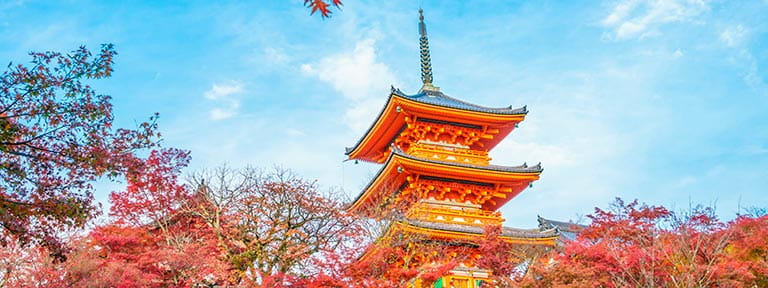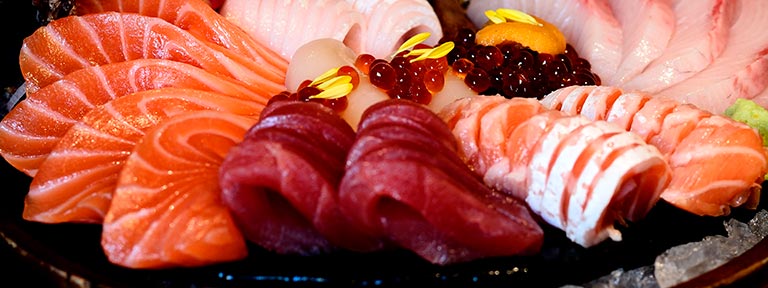Destination guides
Seven reasons to visit Japan
16th April, 2019
A visit to Japan is a common item on the list for the discerning traveller. The land of the rising sun is a colourful umbrella that houses a myriad of sub-cultures and contrasts. From neon lights and speedy bullet trains, to Buddhist temples and tranquil gardens and from high tech gadgets and crazy karaoke to ancient traditions, Japan will draw you in and leave you feeling culturally mind‑blow.
We have seen a steady increase in travel to Japan over the last few years, largely due to Lumley’s Japan series, aired on ITV in 2016. She warmed our hearts with a 4-part adventure across four of Japan’s major islands, visiting the site of Hiroshima and taking a beautiful trip to Mount Fuji.
We expect tourism to increase further as we get closer to the rugby world cup in September 2019 and passengers book a trip of a lifetime to Japan, to coincide with the tournament.
Visiting Japan
Read the guide books and they will all say pretty much the same thing in terms of what’s good to visit. We have included a few of these classics, but we have thrown in some of the more unusual reasons to visit this stunning country to show you that there is a depth to Japan that is well worth unveiling.
1. Cherry blossom

Visit Japan in the springtime and you’ll see the beautiful bloom of cherry blossom – a stunning visual contrast to the tech landscape of the cities. These deeply symbolic flowers are highly appreciated by the Japanese for their short life – a reflection of the existence of life itself. So poignant is the cherry blossom bloom, that locals hold hanami picnics under the trees, to celebrate their beauty.
Cherry blossom is often used to flavour Japanese sweets and its petals are often sprinkled in coffee.
The most popular places to see Japan’s famous cherry blossom in Tokyo is Shinjuku Gyoen or Ueno Park. In Kyoto it’s Philosopher’s Path and Maruyama Park. The best time to catch it at its most beautiful is early April.
2. Tokyo

Often coined the world’s best city, Tokyo may be an obvious reason to visit Japan, but there is a plethora of weird and wonderful reasons to spend some time here. For a light-hearted induction into the city’s delights, Japanese karaoke is a must. It may be a bit of a joke to western culture but in Japan it’s a serious night out and there are hundreds of karaoke bars offering everything from karaoke in a hot tub to private rooms themed to Hello Kitty or the Vietman War.
Another fabulous reason to visit Tokyo is to experience the Japanese railway system. Sophisticated, speedy and highly efficient, you can visit literally anywhere by train and reasonably inexpensively, meaning you can take it more of the city’s delights and beyond.
Film buffs can check out the New York bar from Lost in Translation, where Bill Murray met Scarlett Johansen. Or for thriller fans, there’s the Gonpachi Restaurant as featured in Kill Bill.
3. Stunning architecture

Japan isn’t short of beautiful architecture. From high tech glass buildings, art deco monuments and traditional Japanese buildings from the Edo period, there is an architectural diversity that will mesmerise you.
You don’t need to look too far to discover traditional Japanese architecture. Whilst the inner cities may be dominated by glass skyscrapers, you can still find traces of the stunning wooden structures that were once so prominent across Japan. From traditional tea houses and stilted houses with sliding screens to the Buddhist temples from the 6th century, you can take a history lesson of Japan by visiting places like Kawagoe - a small city near Tokyo with old Japanese buildings that have been converted into shops, cafés, and restaurants.
For modern architecture, pay a visit to the Ribbon Chapel in Hiroshima, or St Mary’s Cathedral a stainless steel and glass abstraction in the heart of Toyko. The Audi Forum or ‘The Iceberg’ as it’s known, in Omotesando is also worth a visit.
4. The cuisine

Japanese food is some of the most beautiful looking food on the planet. From the well-known tradition of sushi and sashimi, to curries, ramens and special teas, Japanese cuisine is a culinary sensation that will assault all your senses.
The food of Japan is very regional, with different specialities being native to specific areas. For this reason, you are likely to experience a diverse gastronomical journey as you travel around the country.
Sushi is the most popular dish of Japan, both outside of Japan and to the Japanese themselves and there is certainly no shortage of sushi restaurants to try out. Tokyo has around 5,000 of them, some specialising in conveyor belt style sushi, some in particular sushi fillings such as fish.
5. Mount Fuji

Mount Fuji is Japan’s highest mountain and is easily accessible from Tokyo. Granted, it is one of the iconic things to see and do when visiting Japan, but here are some lesser known reasons why the mount Fuji is a place of cultural significance.
It’s an active volcano but few people realise that it’s actually three volcanos in one - Fuji at the top, Kofuji in the middle and Komitake at the bottom.
Before 1868, women were not allowed to visit the sacred site, but in 1869 the summit was reached by a British woman, Lady Fanny Parkes, the wife of an ambassador.
During WWII it’s believed that the CIA were planning on painting Mount Fuji red as an act of psychological warfare. They planned to do this by dropping red paint from the air but this never unfolded.
6. Surprisingly good beaches

When you think of Japan, the beaches might not be one of the first things that springs to mind, but there are some stunning beaches that are well worth a visit. Due to the country’s shape, it has a long stretch of coastline on both sides. The best beaches are located in the south in Okinawa – part of an archipelago of islands in the East China Sea. White sandy beaches and coral reefs make for an idyllic place to relax and take a swim in the turquoise waters.
If you’re visiting Kyoto, beach lovers can head to Wakasa Wada Beach, located on the shores of the Sea of Japan and Asia’s first Blue Flag Beach. For Osaka beaches, head to the region of Kansai to check out Nishiki Beach or Tokimeki Beach.
7. Geisha culture

The Geisha girl culture is a fascinating one and is a subject of intrigue for many a tourist to Japan. Geisha girls have long been wrongly tarnished as glorified call girls, as a result of misconceptions from war time. They are in fact entertainers, who undergo gruelling training and forgo their education and freedom to become experts in art, dance and music.
Despite the punishing schedules for the young girls when they are first recruited, there is a strong sense of pride and honour in finally becoming a fully-fledged Geisha, known as a Geiko. Geisha’s are considered celebrities in Japan and entertain many different types of people, from royalty to businessmen and women.
The white face is one of the iconic symbols of the Geisha girl and was originally done to accentuate the facial expressions during a time when only candlelight was used. With modern-day lighting, it’s no longer necessary, but it is still widely done to celebrate tradition.
There are many other reasons to visit Japan – from experiencing ancient customs to immersing yourself in a forward-thinking technological culture. For more inspiration, why not get in touch with one of our friendly advisors.
The opinions expressed are those of the author and are not held by Saga unless specifically stated.
The material is for general information only and does not constitute investment, tax, legal, medical or other form of advice. You should not rely on this information to make (or refrain from making) any decisions. Always obtain independent, professional advice for your own particular situation.





